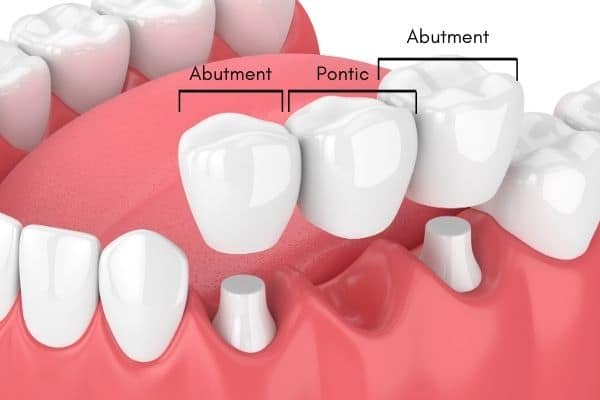How to Care for a Dental Bridge? 10 Essential Tips for Bridge Maintenance

To care for a dental bridge, maintain good oral hygiene and visit the dentist regularly for check-ups and cleanings. A dental bridge requires proper cleaning and care to ensure its longevity and maintain oral health.
By following these guidelines, you can keep your dental bridge in excellent condition and prevent any potential complications or damage. Taking steps to care for your dental bridge will help you enjoy a beautiful smile for years to come.

Credit: dentalstudio.sg
Understanding Dental Bridges
A dental bridge is a dental restoration device used to replace a missing tooth or multiple missing teeth. It consists of a false tooth or teeth, known as pontics, which are anchored to the adjacent natural teeth or dental implants. Dental bridges fill the gap created by missing teeth, improving both the appearance and functionality of the teeth.
What Is A Dental Bridge?
A dental bridge is a false tooth or teeth that are used to replace one or more missing teeth. It is securely anchored to the adjacent natural teeth or dental implants, creating a bridge to fill the gap.
Types Of Dental Bridges
| Types of Dental Bridges | |
|---|---|
| Traditional bridges: | These bridges consist of one or more pontics anchored to adjacent teeth using dental crowns. |
| Cantilever bridges: | These bridges are used when there is only one adjacent tooth present to support the pontic. |
| Maryland bridges: | These bridges are made of a porcelain or metal framework that is bonded to the adjacent teeth using a resin cement. |
| Implant-supported bridges: | These bridges are supported by dental implants instead of natural teeth. |
Each type of dental bridge has its own advantages and considerations, and the best option for an individual will depend on various factors such as the location and condition of the missing teeth, overall oral health, and budget.
Maintaining Oral Hygiene For Dental Bridges
Proper oral hygiene is essential for the longevity and functionality of dental bridges. Brushing your teeth twice a day using soft-bristled toothbrush is crucial. Focus on cleaning the bridge thoroughly, ensuring you reach all the surfaces including underneath the bridge. Incorporate gentle circular motions to remove any plaque or debris.
Another important step is flossing. Gently slide the floss underneath the bridge and clean along the gumline. Consider using interdental brushes or water flossers, as they can effectively remove debris and plaque from hard-to-reach areas.
Mouthwash is a helpful addition to your oral care routine. Rinse your mouth with an antiseptic mouthwash after brushing and flossing to combat bacteria and freshen your breath.
By following these simple steps, you can ensure that your dental bridge remains clean and well-maintained, promoting good oral health and enhancing its longevity.
Eating And Drinking Tips For Bridge Maintenance
Learn proper care techniques for dental bridges, including tips on eating and drinking. Maintain your bridge’s durability with these easy-to-follow guidelines.
Choosing the right food for dental bridges: Ensuring proper maintenance of your dental bridge starts with a smart food selection. Opt for softer and easier-to-chew foods.
Avoiding sticky and hard food: Steer clear of sticky and hard foods that can put excessive pressure on the bridge and potentially compromise its stability. This includes caramel, hard candies, crunchy nuts, and tough meats.
Drinking habits to protect dental bridges: Minimize the consumption of beverages that are high in sugar or acidity, as they can erode the protective layer of the bridge. Regularly rinse your mouth with water after consuming such drinks.
Tips for eating with dental bridges: It is recommended to cut food into smaller, bite-sized pieces to prevent unnecessary strain on the bridge. Additionally, chew food on both sides of your mouth to distribute the pressure evenly.
Preventing Damage To Dental Bridges
Regular dental check-ups are essential for preventing damage to dental bridges. Your dentist will be able to examine the bridge and identify any issues or signs of wear and tear. It is recommended to schedule check-ups and cleanings every six months to maintain the health of your bridge.
Practicing good oral habits is also crucial in caring for a dental bridge. This includes brushing your teeth twice a day with a soft-bristled toothbrush and fluoride toothpaste. Flossing daily, especially around the bridge area, helps remove plaque and food particles that can lead to dental decay.
If you have bruxism (teeth grinding) which can put excessive pressure on dental restorations, wearing a dental night guard can protect your bridge and prevent damage. Your dentist can create a custom-made night guard to fit your teeth comfortably.
When engaging in physical activities or contact sports, it is important to protect your dental bridges. Wearing a mouthguard can help cushion any impact or trauma to the mouth and preserve the integrity of your bridge.
Cleaning And Protecting Dental Bridges
Proper care of a dental bridge is essential for ensuring its longevity and maintaining oral health. To effectively clean and protect dental bridges, start by using a soft toothbrush with gentle bristles. This will prevent any potential damage to the bridge or surrounding teeth.
Next, it is important to employ the right techniques for cleaning the dental bridge. Brush thoroughly and make sure to clean all surfaces, including the area where the bridge meets the gums. Floss daily, utilizing threader floss or superfloss to reach underneath the bridge and remove any debris or plaque.
Additionally, using bridge cleaning aids like interdental brushes, water flossers, or antimicrobial mouthwash can help in maintaining oral hygiene. These aids make it easier to clean hard-to-reach areas effectively.
To protect your dental bridge, it is important to avoid harmful substances and habits. Refrain from biting or chewing hard objects and avoid chewing sticky or hard foods that may put excess pressure on the bridge. Furthermore, it is crucial to avoid smoking and limit consumption of stain-causing substances like coffee, tea, and tobacco as they can discolor the bridge.
Handling Discomfort And Sensitivity
If you experience any initial discomfort after getting a dental bridge, don’t worry as it is quite common. Your gums and adjacent teeth may need some time to adjust to the new appliance. With time, the discomfort should subside.
Sensitivity to hot or cold foods and beverages is normal, especially for the first few weeks. To alleviate this, avoid extremely hot or cold items and use toothpaste specifically designed for sensitive teeth. Additionally, using a soft-bristled toothbrush can help.
If your discomfort or sensitivity persists or worsens over time, it is advisable to consult your dentist. They can examine your dental bridge and ensure there are no underlying issues causing the discomfort.
- Practice good oral hygiene by brushing and flossing regularly to maintain overall dental health.
- Avoid sticky and hard foods that may put excessive pressure on the dental bridge.
- Follow any specific care instructions provided by your dentist.
- If you engage in activities that involve impact to the mouth, such as contact sports, consider using a mouthguard to protect your dental bridge.
Understanding Potential Bridge Issues
Common dental bridge problems include a loose or ill-fitting bridge, which can cause discomfort and affect the functionality of the bridge. If you notice any movement or discomfort with your bridge, it is important to see your dentist immediately.
Another potential problem is a chipped or cracked bridge. This can occur due to accidents or biting down on hard foods. If you experience any damage to your bridge, schedule an appointment with your dentist to assess the situation and determine the best course of action.
Lastly, bridge detachment can be a concern. This typically happens when the bridge becomes detached from one or both abutment teeth. If you feel your bridge is loose or notice it has come off, contact your dentist right away.
Addressing Dental Bridge Discoloration
A dental bridge is a popular solution for replacing missing teeth and restoring a confident smile. However, like natural teeth, bridges can become discolored over time. Understanding the causes of bridge discoloration and taking preventive measures can help maintain their appearance.
One common cause of bridge discoloration is the consumption of dark-colored beverages and foods such as coffee, tea, red wine, and berries. These substances can leave stains on the bridge material. To prevent staining, it is advisable to limit the intake of these items or rinse the mouth with water after consuming them.
Regular professional teeth cleaning is essential for bridge maintenance. Professional cleanings can remove plaque, tartar, and surface stains that can cause discoloration. Dentists use special tools and techniques to clean the bridge thoroughly, ensuring its longevity and appearance.
If bridge discoloration becomes a concern, there are teeth whitening options available. However, it’s important to consult with a dentist to determine the most appropriate method for your specific bridge material. Options may include professional whitening treatments or the use of whitening toothpaste specifically designed for bridges.
| Causes of bridge discoloration | Preventing bridge staining | Professional teeth cleaning for bridge maintenance | Teeth whitening options for bridges |
|---|---|---|---|
| Consumption of dark-colored beverages and foods | Limited intake or rinsing mouth with water | Regular professional cleanings | Consultation with a dentist |
| Remove plaque, tartar, and stains | Professional whitening treatments | ||
| Whitening toothpaste for bridges |
Extending The Lifespan Of Dental Bridges
Extending the lifespan of your dental bridge requires proper care and maintenance. A crucial aspect is maintaining an optimal oral care routine for bridges. This includes brushing twice a day with a soft-bristle toothbrush and fluoride toothpaste. Flossing is equally essential to prevent plaque buildup around the bridge area. Additionally, using an antiseptic mouthwash can help reduce bacteria and maintain oral hygiene.
Regular professional cleaning and maintenance are vital for the longevity of your dental bridge. Routine dental check-ups allow your dentist to identify any issues early on and provide appropriate treatment. They will also clean your bridge thoroughly, removing any stubborn plaque or tartar.
If your dental bridge sustains damage, replacement or repair options may be necessary. Your dentist will evaluate the extent of the damage and suggest the most suitable solution. It is important to address any issues promptly to ensure the longevity of your bridge and avoid further complications.
Understanding the long-term expectations for dental bridges is important. While bridges can last for several years, they may require eventual replacement due to wear and tear. Maintaining good oral hygiene and following your dentist’s recommendations significantly contribute to their lifespan.
Frequently Asked Questions On How To Care For A Dental Bridge?
What Not To Do After Getting A Bridge?
After getting a bridge, avoid eating hard or sticky foods to prevent damaging the bridge. Maintain good oral hygiene by brushing twice a day, flossing regularly, and using an antimicrobial mouthwash. Avoid smoking and excessive alcohol consumption, as they can affect the health and longevity of the bridge.
Regular dental check-ups are essential to ensure the bridge stays in good condition.
How Do You Clean Under A Dental Bridge?
To clean under a dental bridge, use a floss threader or interdental brush to remove food particles and plaque. Gently slide the tool under the bridge and clean both sides daily. Regular dental check-ups and professional cleanings are also vital to maintaining oral health.
Avoid using excessive force to prevent damage to the bridge.
How Often Should You Clean Under A Dental Bridge?
Clean under your dental bridge regularly to maintain oral hygiene. This prevents plaque buildup and eliminates food particles that can cause bad breath and dental issues.
How Do You Take Care Of Your Teeth After A Dental Bridge?
To care for your teeth after a dental bridge: 1. Brush twice a day with a soft-bristle toothbrush. 2. Use a fluoride toothpaste to protect against decay. 3. Floss daily to remove plaque and food debris. 4. Avoid biting down on hard foods or using your teeth as tools.
5. Schedule regular dental check-ups to maintain your bridge’s durability and overall oral health.
Conclusion
Proper care and maintenance of your dental bridge is essential to ensure its longevity and functionality. By following a few simple steps, such as practicing good oral hygiene, avoiding harmful habits, and scheduling regular dental check-ups, you can keep your dental bridge in top condition.
Remember, a well-cared-for dental bridge can provide you with years of beautiful smiles and optimal dental health. So, commit to taking care of your dental bridge today and enjoy the benefits for years to come.




